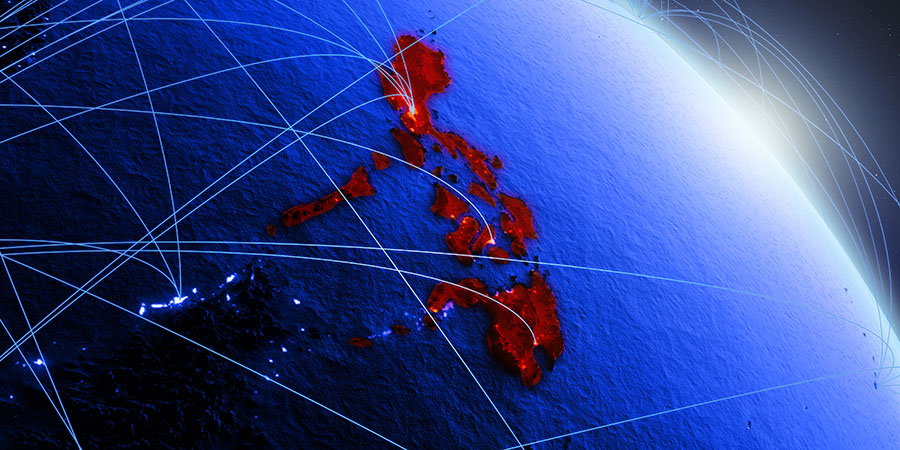The Philippines has experienced a significant increase in the use of digital technology in several industries, primarily driven by a tech-savvy population, government policies that encourage digital adoption and investments both locally and internationally.
The e-commerce industry has also been gaining traction in the country following the emergence of e-commerce platforms. According to a report by the United Nations Economic and Social Commission for Asia and the Pacific (ESCAP), the Philippines ranked fifth in terms of e-commerce traffic in East Asia.
Investments in Digitalization
The digitalization in the Philippines was heavily affected by the COVID-19 pandemic. The pandemic has highlighted the digital divide in the country, especially in remote and underserved areas.
The obvious digital gap prompted a surge in both private and public funding, revitalizing the country’s ambitions towards digitalization.
According to the Philippine Statistics Authority (PSA), the digital economy in the Philippines reached USD 36.5 billion in 2022, an 11% increase compared to the previous year. This growth includes digital transactions across infrastructure, e-commerce, and digital media.
The Philippine Development Plan (PDP) was established to serve as a road map for the country to reach its targets by 2028. The plan delineates strategies essential for driving substantial economic and social transformation, focusing on revitalizing job creation, accelerating poverty eradication, and prioritizing digital transformation as a cornerstone of national progress.
The government has since taken various steps to digitalize essential public services, such as improving telecommunication infrastructure, integrating online government services into a single platform through the eGov PH Super App, implementing the national broadband plan to improve internet and mobile services, and prioritizing cloud-based policies.
The amendment to the Public Service Act—which previously allowed 100% foreign ownership of public services like telecoms—is also a significant legislative achievement that demonstrates the country's dedication to creating a supportive atmosphere for ICT innovation and investment.
The Philippines has also opened its doors for more investments through initiatives such as, GoDigital Pilipinas, led by the Private Sector Advisory Council, to drive the country’s digital journey. These efforts align with the vision of global internet access, promoting inclusivity and empowerment nationwide.
Digitalization and Inclusivity Efforts
The Philippines' dedication to the development of the ICT sector has resulted in an increase in investment approvals, as documented by the Board of Investments. The country reportedly achieved its highest-investment approvals yet, amounting to PHP 1.16 trillion, a 59% increase compared to 2022.
The ICT sector played an essential role in promoting economic progress, with investment approvals amounting to PHP 96.16 billion.
Partnerships between the public and private sectors have contributed to the growth of investments in the Philippines, such as the PHP 5.6 billion investment from Japanese telecoms company, IPS Incorporated. Additionally, IPS affiliate, InfiniVAN, has also invested PHP 4 billion to accelerate the implementation of the National Broadband Plan—a key infrastructure initiative set to transform nationwide connectivity.
The Department of Information and Communications Technology will prioritize establishing secure and reliable internet connections to provinces in remote locations.
The National Fiber Backbone program, which consists of a fiber backbone that is neutral and responsive to demand, is expected to transform the country's digital infrastructure. Its purpose is to provide easy access to the internet for government institutions and other DICT last-mile projects, such as the Free Public Internet Access Program (FPIAP). The FPIAP aims to provide zero-cost internet access in public spaces nationwide.
This is also expected to serve as the foundation for the country's National Broadband Program (NBP), designed to enhance ICT infrastructure and enhance internet connection across the entire country.
While undergoing digitalization, the government is also expected to improve its cybersecurity measures, especially following several reported attacks and threats to its websites in recent months.
DICT has also put the National Cybersecurity Plan in place. This comprehensive framework seeks to strengthen cybersecurity policies, protect national interests, and enhance the capabilities of the cybersecurity profession through 2028.
The creation of the National Security Operations Center (NSOC) and the inclusion of the Armed Forces of the Philippines (AFP) in the National Computer Emergency Response Team (NCERT) demonstrate the country's commitment to successfully countering cyber threats.
As the Philippines embarks on its digital journey, there are numerous opportunities for international and local investors to take part in its digital transformation. The ICT landscape of the Philippines is a work in progress that promises a bright future where the digital divide does not exist.





